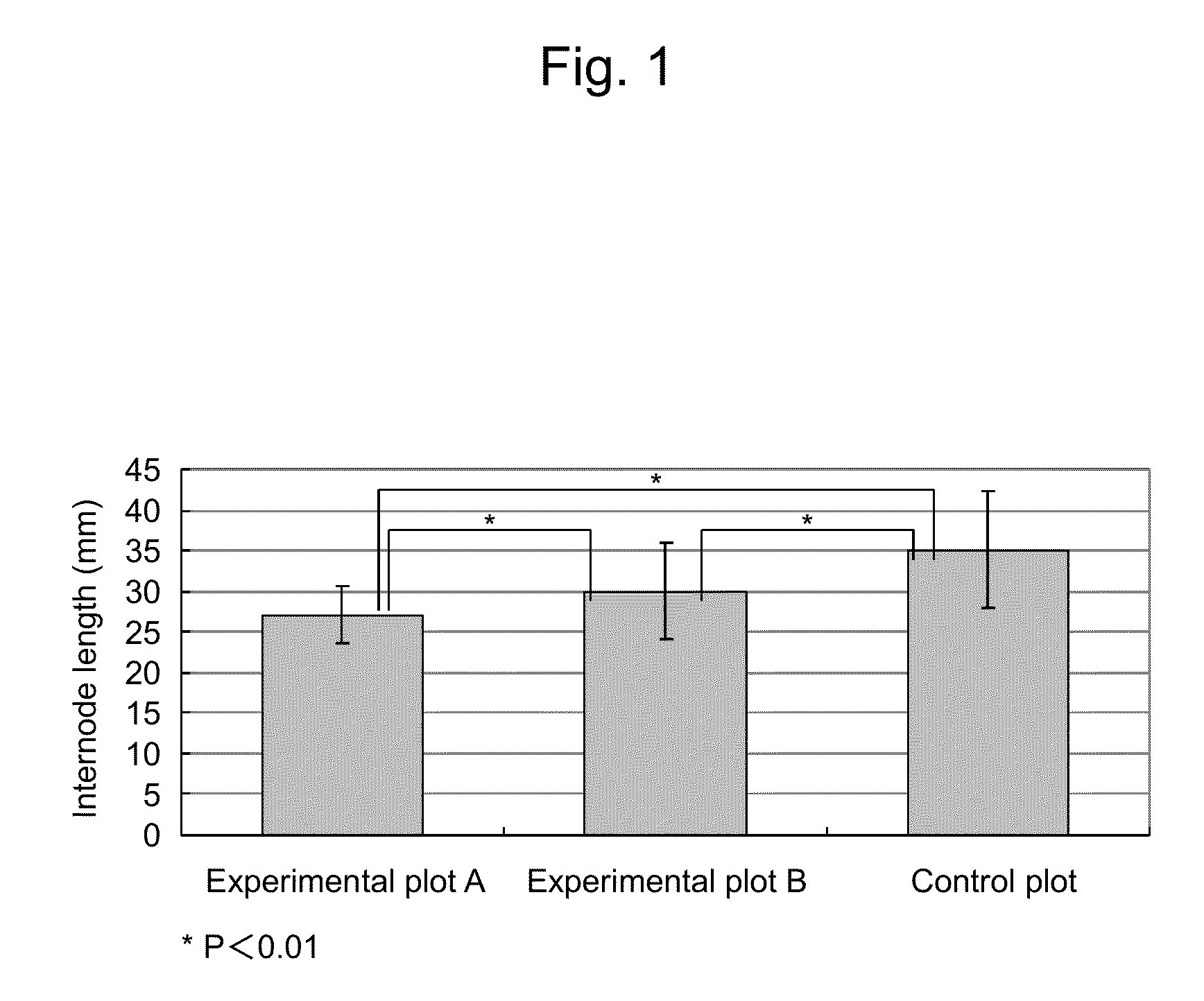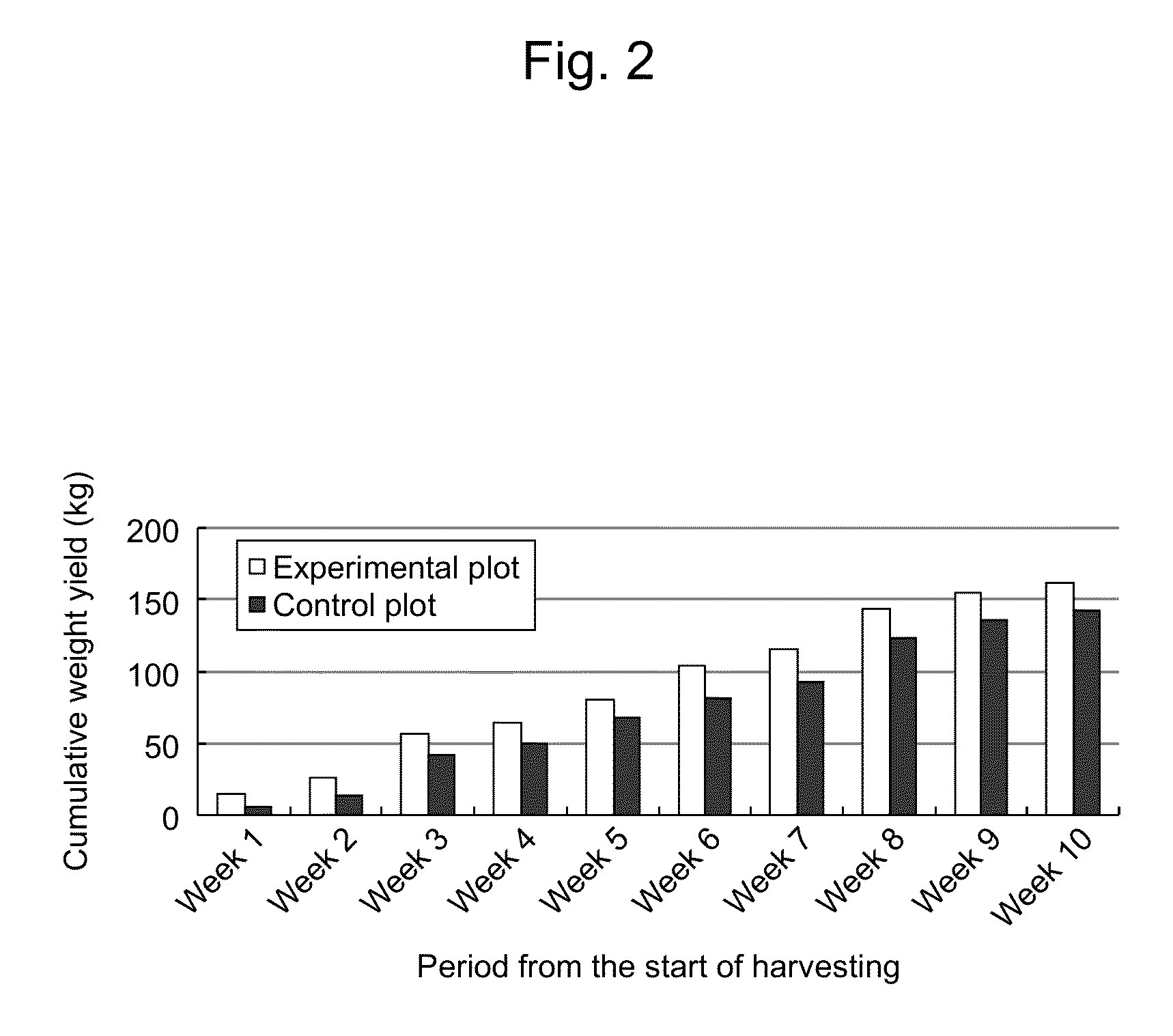Method for cultivating crops using bacterium belonging to genus bacillus
a technology of genus bacillus and cultivating methods, applied in the field of cultivating crops using genus bacillus bacteria, can solve the problems of significant labor and time consumption, deterioration of quality in terms of nutrients or the like, etc., and achieve the effect of increasing the yield of crops and promoting the growth of crops
- Summary
- Abstract
- Description
- Claims
- Application Information
AI Technical Summary
Benefits of technology
Problems solved by technology
Method used
Image
Examples
example 1
Mixing of the Strain into Soil
[0048]Bacillus subtilis C-3102 strain (FERM BP-1096) (1×1010 cfu / g) was added to a nursery compost for tomato cultivation to result in a concentration of 1% (w / v) or 0.1% (w / v), followed by sufficiently mixing them. Three plots were prepared with the addition of the Bacillus subtilis C-3102 strain (FERM BP-1096) to soil at the following concentrations and then subjected to testing: 1% (w / v) for experimental plot A, 0.1% (w / v) for experimental plot B, and no addition of Bacillus subtilis C-3102 strain (FERM BP-1096) for control plot. Table 1 shows the results of the colony count for Bacillus subtilis C-3102 strain (FERM BP-1096) after mixing.
TABLE 1Mixing rate (w / v) ofColony count (cfu / g) ofB. subtilis C-3102B. subtilis C-3102Plot(FERM BP-1096)(FERM BP-1096)Experimental plot A1.0%1.1 × 108Experimental plot B0.1%1.6 × 107Control plot—N.D.N.D. 2 cfu / g
[0049]Tomato seeds were seeded in plug pots at 262 seeds per plot and subsequently cultivated for about two...
example 2
Mixing of the Strain into Soil
[0051]Bacillus subtilis C-3102 strain (FERM BP-1096) (1×1010 cfu / g) was added to a nursery compost for tomato cultivation at a concentration of 0.1% (w / v), followed by sufficiently mixing them. Two plots were prepared with the addition of Bacillus subtilis C-3102 strain (FERM BP-1096) to soil at the following concentrations and then subjected to testing: 0.1% (w / v) for an experimental plot and no addition of Bacillus subtilis C-3102 strain (FERM BP-1096) for control plot. Table 3 shows the results of the colony count for Bacillus subtilis C-3102 strain (FERM BP-1096) after mixing.
TABLE 3Mixing rate (w / v) ofColony count (cfu / g) ofB. subtilis C-3102B. subtilis C-3102Plot(FERM BP-1096)(FERM BP-1096)Experimental plot0.1%1.0 × 107Control plot—N.D.N.D. 2 cfu / g
[0052]The tomato seedlings were transferred to a drip irrigation system in the manner described in Example 1. Cultivation was performed while supplying water and liquid fertilizers. When tomato fruits ri...
example 3
Mixing of the Strain into Soil
[0057]Bacillus subtilis C-3102 strain (FERM BP-1096) (1×1010 cfu / g) was added to a nursery compost for tomato cultivation to result in a concentration of 0.1% (w / v), followed by sufficiently mixing them. Two plots were prepared with the addition of Bacillus subtilis C-3102 strain (FERM BP-1096) to soil at the following concentrations and then subjected to testing: 0.1% (w / v) for an experimental plot and no addition of Bacillus subtilis C-3102 strain (FERM BP-1096) for a control plot. Table 8 shows the results of the colony count for Bacillus subtilis C-3102 strain (FERM BP-1096) after mixing.
TABLE 8B. subtilis C-3102B. subtilis C-3102(FERM BP-1096)(FERM BP-1096)Plotmixing rate (w / v)colony count(cfu / g)Experimental plot0.1%1.0 × 107Control plot—N.D.N.D. 2 cfu / g
[0058]Tomato seeds were seeded and cultivated for about two weeks. Then, the obtained tomato seedlings were cultivated in pots (90 mm) using the soil prepared above, and 246 seedlings and 240 seedli...
PUM
 Login to View More
Login to View More Abstract
Description
Claims
Application Information
 Login to View More
Login to View More - R&D
- Intellectual Property
- Life Sciences
- Materials
- Tech Scout
- Unparalleled Data Quality
- Higher Quality Content
- 60% Fewer Hallucinations
Browse by: Latest US Patents, China's latest patents, Technical Efficacy Thesaurus, Application Domain, Technology Topic, Popular Technical Reports.
© 2025 PatSnap. All rights reserved.Legal|Privacy policy|Modern Slavery Act Transparency Statement|Sitemap|About US| Contact US: help@patsnap.com


